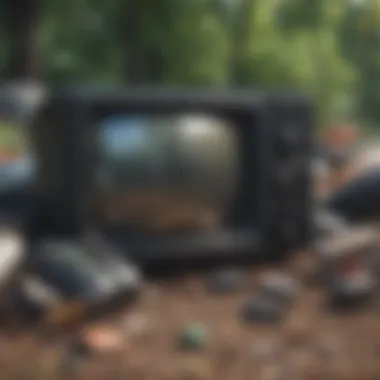Recycling Old TVs: A Comprehensive Guide


Overview of the Topic
Recycling old televisions has become paramount in today’s society. The rapid pace of technology development results in consumers frequently upgrading their electronic devices, leading to a growing collection of obsolete TVs. This presents significant environmental challenges.
Televisions contain various materials, many of which can be harmful if improperly disposed of. This guide aims to inform readers about local recycling options, which can mitigate the environmental impact of discarded electronics. Understanding this issue helps foster responsible consumer behavior, reducing landfill waste while promoting sustainable practices.
Current Status and Challenges
According to research, millions of old televisions end up in landfills each year. This trend poses risks. Lead, cadmium, and other toxic substances from these devices can seep into soil and waterways, damaging ecosystems and potentially harming human health.
Several challenges exist in recycling old TVs:
- Lack of awareness among consumers regarding recycling options.
- Insufficient local facilities equipped to handle e-waste.
- Financial constraints that discourage proper disposal methods.
Even as regulatory frameworks evolve, many individuals still struggle to find accessible channels for recycling, creating a cycle of negligence.
Sustainable Solutions
The push for sustainable electronics recycling has gained momentum. Numerous programs are aimed at improving disposal methods. Many cities now have designated drop-off locations for e-waste, including old televisions.
Consumers also have the option to donate working televisions to non-profit organizations, extending the lifecycle of these devices while helping those in need.
Successful case studies demonstrate that education is key. For instance, programs like the electronic waste recycling events in Seattle have proven effective in raising awareness and participation. These community-driven efforts can inspire other areas to adopt similar initiatives.
Impact and Importance
The impact of responsible television recycling extends beyond mere disposal. It is critical for protecting ecosystems, communities, and future generations. Proper recycling reduces the extraction of finite resources needed to produce new devices, which in turn decreases energy consumption and pollution.
Conservation efforts are crucial. By choosing to recycle old TVs, individuals contribute to a larger movement advocating for a more sustainable future. This collective action can lead to significant environmental benefits, fostering healthier communities and ecosystems.
"Responsible recycling not only conserves natural resources but also alleviates the burden of e-waste on our planet."
Through informed choices, consumers can ensure they play a part in safeguarding the environment for generations to come.
For additional information on recycling practices, you can visit Wikipedia, Britannica or discussions on Reddit for community insights.
Prelims to Television Recycling
Television recycling is a crucial subject in today’s environment-conscious society. As technology evolves rapidly, older television sets are often cast aside, contributing to the growing issue of electronic waste. This article addresses the specificity of recycling televisions, outlining essential information to equip readers with the knowledge needed to navigate local recycling options effectively.
Importance of Recycling Electronics
The importance of recycling electronics cannot be overstated. Electronic devices, such as televisions, contain many materials that are not only valuable but also hazardous. Recycling these items helps recover precious metals like gold and copper while reducing the need for further mining. This mining process is often destructive to the environment and contributes to pollution.
Moreover, recycling televisions reduces landfill waste. Landfills are already overburdened with waste, and adding old electronics exacerbates the problem. Once a television is disposed of improperly, it begins to leach harmful substances into the soil and water supply.
Lastly, electronic recycling can bolster job creation, stimulating local economies by establishing jobs in recycling centers and processing plants. Therefore, educating oneself on proper recycling practices is vital for both individual and collective environmental responsibility.
Environmental Impacts of Disposing TVs
Disposing of old televisions can have significant adverse environmental impacts. Traditional disposal methods, like tossing an old TV into a landfill, can lead to various environmental issues. Old televisions can release toxic substances such as lead, mercury, and cadmium as they break down. These materials can contaminate soil and groundwater, potentially entering the food chain.
Additionally, e-waste contributes to air pollution if burned. Burning electronics releases harmful smoke and chemicals into the atmosphere, adversely affecting air quality and public health.
In contrast, responsible recycling mitigates these impacts. By properly recycling electronics, we can ensure that hazardous materials are handled safely, preventing them from causing environmental harm. It isn’t just about removing devices from our homes; it's about ensuring the materials are dealt with properly, securing a healthier future for everyone.
"The act of recycling TVs is a vital step towards environmental conservation, affecting local ecosystems and global sustainability."
Understanding the implications of proper recycling can foster a community that values environmental health and encourages informed actions when managing old electronics.
Understanding the Composition of Old TVs
Understanding the composition of old televisions is crucial for any comprehensive discussion on recycling. Knowing what materials make up different types of televisions helps in making informed choices about recycling and disposal options. It enables recyclers to efficiently process these components, ensuring that harmful substances are handled correctly and valuable materials are recovered effectively. This section will outline the types of TVs and the hazardous materials they may contain, emphasizing the importance of this knowledge in the recycling process.
Types of TVs: CRT vs. vs. Plasma
Old TVs primarily fall into three categories: CRT (Cathode Ray Tube), LCD (Liquid Crystal Display), and Plasma. Each type exhibits distinct differences in construction and material usage, which affect how they should be recycled.
- CRT TVs are the bulky televisions often found in many homes. They use a glass tube to display images, which contains lead, a highly toxic substance. Handling CRTs during recycling requires special precautions to avoid exposure and environmental contamination.
- LCD TVs are slimmer and lighter. They use liquid crystals and include various electronic components. LCDs also contain hazardous materials, such as mercury, particularly in the backlight. Recycling facilities must treat these components with care to prevent harmful substances from entering the environment.
- Plasma TVs have similar risks to LCDs but may contain additional hazardous materials and larger amounts of glass. Their structure involves intricate electronic parts that demand careful recycling to recover metals and other reusable materials.
In summary, each TV type poses unique considerations, influencing the recycling methods needed. Knowledge of these differences aids recyclers in implementing the right processes and safeguards to protect both the environment and public health.
Hazardous Materials in Old TVs
Recycling of old TVs isn't just about reusing materials; it also involves managing hazardous substances properly. Old televisions can contain various toxic materials, including:


- Lead: Commonly found in CRTs, lead can leach into soil and water, causing serious health issues.
- Mercury: Present in LCD TVs, mercury is toxic and can affect the nervous system if not handled correctly.
- Cadmium: Found in some older models, cadmium is a carcinogen and poses risks during the recycling process.
These hazardous materials necessitate responsible recycling practices. Failing to do so can lead to significant environmental and health consequences. Safe disposal and recycling of old TVs protect landfills and ensure that dangerous materials do not harm communities.
"Proper recycling is not only about recovery; it is also about prevention of contamination and protection of our environment."
Overall, understanding the composition of old TVs is not simply an informative task; it is essential for promoting effective recycling practices that benefit society and the environment. It equips individuals and organizations with the knowledge to make responsible choices in their disposal efforts.
Local Recycling Options for Old TVs
Recycling old televisions offers significant benefits. Not only does it aid in reducing environmental waste, but it also contributes to the conservation of valuable resources. Understanding your local recycling options is essential. This ensures that you dispose of your old TV responsibly. Making use of local services helps to minimize the impact on landfills and reduces pollution.
Finding Local Recycling Centers
Identifying local recycling centers is the first step in responsibly disposing of your old television. Most cities and towns have designated facilities or programs aimed at recycling electronic waste. You can start by checking your city’s official website for information on these centers. Many municipalities provide a list of approved recycling facilities that specialize in handling e-waste.
It's useful to search on platforms like Reddit where local communities often share recommendations for recycling locations. This ensures you find reliable options that follow environmental guidelines.
Additionally, various online directories exist that can help you find recycling centers close to your home. These directories typically include user reviews and can give you insight into the services offered by each facility.
Municipal Guidelines and Regulations
Every locality has its own set of guidelines and regulations concerning the recycling of electronic waste. Understanding these rules is crucial for ensuring compliance and safe recycling. Local governments often dictate how residents should prepare their old TVs for recycling.
For instance, certain items may need to be disassembled before recycling, while others should not enter regular waste. Knowing these regulations helps prevent potential fines and ensures your effort contributes positively to environmental conservation.
If you are uncertain about the requirements in your area, consult your city’s waste management department. They can provide comprehensive information and clarify any doubts. Additionally, staying updated on changes to regulations is important as these can evolve, reflecting advancements in recycling technologies and environmental policies.
Preparing Your Old TV for Recycling
The process of recycling old TVs starts well before they are physically delivered to a recycling center. Proper preparation of your old television is essential. This can not only ensure safety but also maximize the chances of valuable materials being salvaged in an environmentally friendly manner. Understanding how to effectively prepare electronics for recycling can mitigate risks associated with hazardous materials and enhance the overall recycling process.
Safely Disconnecting and Packaging
When it's time to remove an old TV for recycling, safety should be the first priority. It is crucial to disconnect all cables and power sources. This step minimizes risk of electrical shock or damage to other devices. Follow these guidelines:
- Unplug the TV: Ensure the television is completely disconnected from the power outlet before handling.
- Remove all accessories: Take off any connected devices, such as gaming consoles or streaming devices. Remove DVD players or external hard drives too.
- Careful handling: Old TVs, especially CRT models, can be heavy and cumbersome. Consider having someone assist you during the lifting.
- Proper packaging: For shipping or dropping off your TV, consider using the original packaging if it is available. If not, try to wrap the device in a thick blanket or bubble wrap to protect it from physical damage.
Following these precautions will prepare the TV well for its journey and help prevent injuries.
Data Security Considerations
Another critical aspect of preparing your TV for recycling is ensuring your data security. While TVs might not store personal data like computers or smartphones, certain smart TVs can have data that may pose privacy concerns. Here are steps to ensure your data remains secure:
- Factory reset the TV: This action will delete stored settings, logins, and any cached content. Refer to the user manual for specific reset instructions based on the model of the TV.
- Disconnect from the internet: If applicable, ensure the TV is disconnected from your Wi-Fi network. This prevents any potential remote access to your device.
- Remove accounts: Make sure to log out of any streaming or app accounts you have on the device.
When recycling old technological devices, always consider potential privacy risks. Taking precautionary measures can save you future headaches.
Taking these steps ensures that you have not only prepared your old TV for recycling but also addressed any possible environmental and security concerns. By approaching the recycling process thoughtfully, you contribute to sustainable practices and responsible electronics recycling.
Drop-off and Pickup Services for Recycling
The process of recycling old televisions involves essential services that facilitate the practical disposal and recycling of electronic waste. Drop-off and pickup services play a crucial role in ensuring that old TVs are disposed of in an environmentally responsible manner. These services provide a timely and efficient way to manage e-waste, allowing individuals to easily understand their options for recycling.
Exploring Drop-off Locations
Finding a suitable drop-off location is a significant step in the recycling process. Many cities have designated centers for e-waste recycling, where you can take your old television. These centers may include local waste management facilities or special e-waste collection events. Some retailers also provide drop-off services for old televisions, which adds convenience for the consumer.
It is essential to verify the operating hours and the types of items accepted at each site before visiting. Here are some suggestions for finding drop-off locations:
- Local Government Websites: Many municipal websites offer information on recycling centers and schedules.
- Retail Stores: Major retailers like Best Buy and Walmart often have recycling programs, allowing you to drop off your old TVs at their locations.
- Community Events: Check for local recycling drives or community clean-up events that might include e-waste collection.
"Proper disposal of electronics is not just about getting rid of them; it is about doing it rightly for the environment."
These options vary by region, but utilizing available resources can lead you to the nearest drop-off point.
Schedule Pickup Services
If drop-off locations are not convenient or accessible, scheduling a pickup service can be an excellent solution. Many recycling companies and local municipalities offer pickup services for bulky items like old televisions. A scheduled pickup can save you time and effort, especially if you have large or multiple units to recycle.
Here’s how to proceed when considering a pickup service:
- Contact Local Recycling Services: Reach out to local recycling businesses or governmental departments that handle e-waste. They can provide information on fees, availability, and the process involved.
- Book in Advance: Given the demand for pickup services, booking ahead is advisable to ensure a timely collection.
- Prepare Your TV: Prior to the scheduled date, make sure your TV is unplugged and ready for collection. Providing easy access makes the process smoother for everyone involved.
This service is particularly beneficial for individuals with mobility issues or those who simply cannot transport their old televisions.


By utilizing drop-off locations and pickup services effectively, individuals can contribute to responsible e-waste management and assist in protecting the environment. The convenience of these options encourages more people to recycle their old TVs, ensuring that valuable materials are reused and hazardous substances are disposed of properly.
Retailer Take-Back Programs
Retailer take-back programs offer a crucial aspect for recycling old televisions. These initiatives represent a partnership between retailers and consumers, focusing on the responsible disposal of electronic waste. As consumers become increasingly aware of environmental issues, these programs cater to their needs while also helping retailers uphold corporate social responsibility. With many people often unsure about how to dispose of their old electronics, these programs streamline the process by providing convenient solutions.
Typically, retailers work with specialized e-waste management services to ensure that the recycled materials are handled properly. This relationship not only reinforces the retailer's commitment to sustainability but also encourages consumers to think of recycling as a feasible option. By participating in these take-back programs, consumers effectively contribute to reducing the environmental impacts associated with e-waste.
Major Retailers Offering Recycling
Numerous retailers have adopted e-waste take-back initiatives. Companies like Best Buy, Target, and Walmart provide drop-off points for customers to recycle their old TVs. Best Buy, for instance, allows customers to bring in items such as televisions and monitors for free depending on size. This easy-to-access service enables users to recycle responsibly without having to travel far.
In addition, some stores may have specific events or designated days for e-waste recycling, encouraging greater public participation. These opportunities not only facilitate responsible disposal but also foster community involvement and awareness regarding electronic waste. Retailers not only benefit from added foot traffic but enhance their image as environmental stewards.
Incentive Programs for Recycling
Incentive programs create an additional motivation for consumers to recycle their unwanted electronics. These can take various forms. Some retailers offer discounts on future purchases when customers recycle old electronics. This "trade-in" approach allows customers to offset the price of new purchases while disposing of unwanted items responsibly.
The benefits do not end with direct incentives. As consumers engage with these programs, they receive valuable educational resources on the importance of recycling electronic devices. This knowledge can foster a more profound commitment to environmental conservation beyond individual actions. Encouraging sustainable behavior among consumers can create a compounding effect, significantly influencing overall e-waste management and reduction.
In summary, retailer take-back programs serve as a bridge between consumer responsibility and proper disposal services. By increasing access and providing incentives, retailers play a key role in promoting the recycling of old TVs. These programs benefit both parties, enabling improved environmental outcomes, and enhancing community involvement in e-waste reduction.
Understanding Recycling Processes
Recycling processes play a crucial role in managing e-waste effectively. TVs, particularly older models, are filled with materials that can be broken down and reused. Understanding how these processes work can help individuals make informed decisions regarding their old TVs. By knowing the steps involved in recycling, people can appreciate the environmental benefits and the economic advantages of recovery of valuable materials.
What Happens to Your Recycled TV?
When you place your old TV in a recycling program, it undergoes various stages.
- Collection: The recycling process begins with the collection of televisions at drop-off centers or through pickup services. Here, TVs are gathered from people looking to recycle them.
- Sorting: Once collected, the TVs are sorted according to their type. This is important because different types of televisions have distinct components that require specific handling. For example, CRTs, LCDs, and plasma TVs all have different recycling processes due to their construction.
- Dismantling: After sorting, the TVs are dismantled. Skilled workers remove components such as circuit boards, plastic casings, and glass screens. This step requires care, especially to handle hazardous materials safely.
- Processing: Once dismantled, the parts are processed separately. Metals, plastics, and glass are crushed and prepared for recycling. Hazards like lead or mercury found in CRTs are disposed of through regulated processes to prevent environmental contamination.
- Recovery: The last step involves recovering usable materials. Metals like gold, copper, and aluminum can be extracted for reuse in new products. This part of the process highlights the economic value of recycling, as recovered materials can save production costs for manufacturers using reclaimed materials instead of virgin resources.
By recycling electronic devices, we not only conserve natural resources but also reduce pollution and energy consumption associated with producing new materials.
Value of Recovered Materials
The recycling of old TVs offers significant value in terms of material recovery. The materials extracted from recycled TVs are essential to several industries. Here are some key points regarding the value of these materials:
- Metals: Valuable metals such as gold, copper, and silver found in circuit boards can be reclaimed. This prevents the need for mining raw materials, reducing environmental impact.
- Plastics: Recycled plastics can be transformed into new products, like containers or construction materials. This contributes to a circular economy, minimizing waste.
- Glass: Glass from screens can be recycled and used in new displays or construction. This process reduces the need for raw sand, a key component required in glass manufacturing.
Understanding the value of recovered materials helps to emphasize the importance of recycling old TVs. It not only supports environmental conservation efforts but also boosts local economies by creating demand for recycled materials.
The Role of E-Waste in Environmental Conservation
E-waste, which includes old TVs, has become a significant environmental concern. When we consider the vast number of electronic devices disposed of each year, it becomes apparent that responsible handling of e-waste is crucial for conserving our environment. Part of this responsibility lies in understanding what happens to these items once they are discarded.
Impact on Landfills and Pollution
Discarded televisions often end up in landfills. This is problematic for multiple reasons:
- Toxic Components: Many older TVs contain hazardous materials such as lead, mercury, and cadmium. When these substances leach into the ground, they can contaminate soil and groundwater, creating long-term health risks for humans and wildlife.
- Space Requirements: TVs take up precious space in landfills. Given the increasing rate of electronic consumption, the growth of e-waste in these areas is unsustainable. Overflowing landfills can lead to the need for new waste sites which require land and resources.
- Greenhouse Gas Emissions: As e-waste decomposes, it produces methane, a potent greenhouse gas. This contributes to climate change. Reducing e-waste through recycling can significantly lower these emissions.
"Recycling e-waste not only conserves resources but also prevents toxic pollution in our landfills."
Community Efforts in Reducing E-Waste
Communities around the world are taking steps to reduce e-waste through various initiatives:
- Awareness Campaigns: Many local governments and organizations run campaigns to educate residents about the importance of recycling e-waste responsibly.
- Recycling Drives: Organizing e-waste collection events allows communities to safely dispose of their old electronics, reducing the likelihood of dumping them in regular trash.
- Partnerships with Retailers: Some communities partner with electronic retailers to offer convenient drop-off points for recycling, making it easier for residents to recycle rather than throw away their old TVs.
- Educational Programs: Schools and universities are increasingly incorporating e-waste education into their curriculums, instilling the value of sustainable practices in the next generation.
It is clear that both individuals and communities play a pivotal role in addressing e-waste. By actively participating in recycling efforts and understanding the impact of improper disposal, we can work toward a more sustainable and healthier environment.
Legal Regulations Surrounding E-Waste Disposal
As electronics continue to evolve, so does the necessity for effective disposal methods. In this context, legal regulations surrounding e-waste disposal play a crucial role. These regulations aim to minimize the harmful effects that outdated electronics, like old televisions, have on the environment. Understanding these laws can help individuals and businesses navigate their recycling responsibilities better, ensuring that valuable materials are not wasted and hazardous substances do not contaminate landfills.
Federal and State Laws
Various laws are in place at both federal and state levels to regulate the disposal of e-waste. At the federal level, the Resource Conservation and Recovery Act (RCRA) provides a framework for managing hazardous waste. Under the RCRA, certain components of old televisions are identified as hazardous, necessitating careful handling and specific disposal methods.
States have further advanced these regulations by establishing their own e-waste laws. For example, California’s Electronic Waste Recycling Act mandates that manufacturers finance the recycling of their products. This ensures that they contribute to the end-of-life management of the tools they sell.
It's essential for residents to be aware of local laws. Violating them can lead to legal consequences, including fines. To stay compliant, always check local guidelines and consider getting involved with community programs that inform residents about e-waste rules.
Compliance for Manufacturers and Retailers


Manufacturers and retailers have a pivotal role in the e-waste ecosystem. Compliance with regulations is not just a legal obligation; it also reflects a commitment to environmental preservation. Many laws require manufacturers to have recycling programs in place, promoting the take-back of old televisions.
Retailers, like Best Buy and Walmart, have initiatives to encourage customers to return their unused electronics. These actions support sustainable practices while complying with legal mandates.
In addition, companies must keep accurate records of how e-waste is processed to ensure that the recycling complies with legal standards. This not only works to maintain transparency but also builds trust with consumers aware of environmental impacts.
"Optimal recycling involves more than just disposal; it indirectly encourages sustainable innovation in manufacturing practices."
E-waste regulations serve a dual purpose. They protect the environment while fostering responsible business practices. By ensuring compliance, manufacturers and retailers contribute to a systematic approach to electronics disposal, ultimately promoting greater accountability within the industry.
Future of Electronics Recycling
The future of electronics recycling is a crucial aspect of managing e-waste. As technology evolves, so does the challenge of disposing of old electronics such as televisions. Without effective recycling methods, the environmental impact will increase. This section will examine key elements and benefits of emerging recycling technologies and sustainable practices that manufacturers are adopting.
Technological Advances in Recycling
Recent years have seen significant technological advancements in the recycling of electronics. New processes are being developed that improve recovery rates of valuable materials. For instance, advanced shredders and separation techniques enhance the extraction of metals like aluminum, copper, and gold from old TVs. These processes reduce the amount of waste that ends up in landfills, which is essential for environmental preservation.
Additionally, innovations in chemical recycling methods allow for the recovery of plastics. With a better understanding of different plastic types found in electronics, recyclers can now efficiently sort and recycle these materials. This is important as improper disposal of plastics can contribute to pollution and harm wildlife.
Furthermore, automation and robotics are increasingly employed in recycling facilities. Such systems can accurately sort materials faster than humans, resulting in an improved recycling process. This not only creates a more efficient workflow but also ensures that more components are processed correctly.
Sustainable Design Practices by Manufacturers
Manufacturers are beginning to recognize the importance of sustainable design in consumer electronics. By focusing on eco-friendly designs, they can facilitate easier recycling when the product reaches the end of its life. Electronic companies like Samsung and LG have started to incorporate recyclables into their products while minimizing harmful materials.
Sustainable design also includes modular construction. This allows for easier repairs and upgrades, extending the life of the product and reducing e-waste. Such practices are becoming critical as consumers demand more durable and environmentally conscious products.
In addition, many manufacturers are adopting life cycle assessments. This approach evaluates the environmental impact of a product from its creation to its disposal. Companies can use this information to improve materials sourcing and production processes, ensuring they are more sustainable overall.
"Embracing sustainable design practices significantly impacts the recycling rate and reduces the environmental footprint of electronics."
These developments contribute to a more responsible approach to electronics production and disposal. As consumers become more aware of their choices, the pressure on manufacturers to invest in green technologies will only grow. Thus, the future of electronics recycling not only hinges on advanced technologies but also on the commitment of manufacturers to sustainable practices.
Challenges in TV Recycling and E-Waste Management
Recycling old TVs comes with various challenges. Understanding these challenges is crucial for effective e-waste management. A lack of awareness and engagement can hinder recycling efforts. Additionally, logistical and financial barriers can complicate the process even further. Addressing these issues is vital in ensuring that recycling practices become more prevalent and effective.
Public Awareness and Participation
Public awareness is an essential aspect of recycling and waste management. Many individuals are unaware of the negative impacts old TVs can have on the environment. Proper education can change this. Through education, communities can be informed about the dangers of e-waste and the importance of recycling. However, generating this awareness is not always straightforward.
Some actions that can help improve public participation include:
- Organizing community recycling events
- Collaborating with local schools and organizations for workshops
- Utilizing social media platforms to spread the message
Engagement can lead to increased participation in recycling programs. It helps create a culture that values sustainability and responsible disposal of electronics. Without widespread public knowledge, many old TVs will continue to end up in landfills, worsening environmental issues.
Logistical and Financial Barriers
Logistical challenges arise in many facets of TV recycling. Collecting old TVs, transporting them, and finding suitable recycling facilities can become a burden. Sometimes the nearest recycling facility is far away, which makes it inconvenient for individuals to recycle their old devices. Some local governments may not have adequate resources to implement proper recycling programs.
Financial barriers also play a role. Many people may hesitate to pay fees associated with recycling programs. This is especially true for individuals who may not see the immediate benefits of recycling their old electronics. Lack of funds can make it difficult for municipalities to develop effective recycling programs.
To counter these barriers, several strategies can be proposed:
- Develop partnerships between public and private sectors to share costs
- Promote awareness campaigns to emphasize long-term benefits associated with recycling
- Consider subsidizing recycling programs to lower costs for consumers
By addressing both logistical and financial barriers, we can create more robust and accessible recycling options for old TVs. This improves the overall efficiency of e-waste management, supporting environmental conservation efforts.
Finale
Recycling old televisions is not just a necessary action; it is a vital part of addressing the wider issue of electronic waste. The significance of this topic is underscored by the increasing volume of discarded electronics, which impose severe environmental challenges. Understanding the various aspects of television recycling allows individuals to take informed actions while promoting sustainability in their communities.
The benefits of responsible recycling extend beyond mere compliance with local regulations. By participating in recycling efforts, individuals contribute to reducing pollution, conserving natural resources, and minimizing landfill burdens. Each step taken towards recycling an old TV is a step towards a cleaner, safer environment.
The aforementioned legal regulations, local recycling options and preparation methods provide a comprehensive framework for individuals to follow. Moreover, awareness of public initiatives and technological advancements will support future efforts in e-waste management. Each of these elements plays a role in fostering responsible recycling practices, ensuring both ecological and social accountability.
Summary of Key Points
- The growing issue of electronic waste necessitates urgent action in recycling old TVs.
- Responsible recycling reduces environmental damage and promotes resource conservation.
- Local recycling centers and retailer take-back programs offer accessible options for disposal.
- Preparing your TV for recycling involves safe disconnection and consideration of data security.
- Awareness of legal regulations is essential for compliance and effective recycling.
Call to Action for Responsible Recycling
As an individual, you hold the power to make significant contributions toward environmental sustainability. Take the following steps to ensure responsible recycling of your old television:
- Research local recycling facilities and understand the guidelines they provide.
- Utilize retailer take-back programs when upgrading to a new television.
- Engage your community in discussions about the importance of recycling electronics.
- Educate others about the hazardous materials found in old TVs and the impact of improper disposal.
- Advocate for stronger regulations regarding electronic waste to help improve industry standards.
"Our choices, no matter how small, can lead to meaningful change in the world around us."
By taking these actions, you contribute to a sustainable future, minimizing the impact of e-waste on our environment and ensuring that valuable materials are reused. Embracing responsible recycling is not merely a personal choice; it is a collective commitment to our planet.



